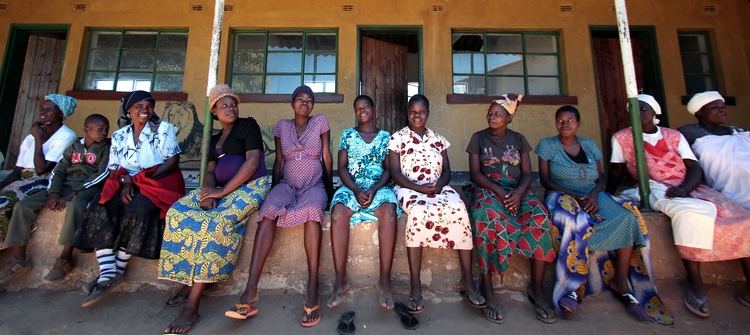
The Sunday Mail

Without any intervention, the chances that a baby born to an HIV-positive mother will be infected are 15 to 30 percent without breastfeeding and 25 to 45 percent with breastfeeding.
Many a time, expectant mothers shy away from seeking health services due to the long queues they are subjected to when they visit health facilities.
Though it hasn’t been made mandatory in Zimbabwe, all expectant mothers are encouraged to undergo an HIV test once they realise they are pregnant to prevent mother-to-child HIV transmission.
However, due to the the rigorous and time-consuming long queues, some pregnant women opt out of the voluntary HIV testing programme, thereby putting their unborn babies at the risk of HIV infection.
Chikwingwizha Mission Clinic in Shurugwi has moved to curb that by introducing a one-stop shop where most tests related to HIV are done in one place.
The one-stop shop has been introduced to improve on the prevention of mother-to-child transmission (PMTCT) and curb stigmatisation of people living with HIV.
Before the introduction of this facility, pregnant women would move back and forth between seven points of care at the same facility. However, this has been reduced to two points only.
From the observation point (where weight, temperature and blood pressure are checked), the expectant mother now proceeds to the one-stop shop where HIV testing and counselling is done.
If found HIV positive, the mother has her CD4 count done and is initiated on life-long anti-retroviral therapy in the same room.
Mrs Pellie Magumise of Nhema village who is expecting her second child applauded the innovation.
“I’m really grateful to the hospital staff for coming up with the one-stop shop for pregnant women because it’s now saving us a lot of time. And even if you test positive, no one will know, which makes it better in terms of stigma and discrimination,” she said.
“Before they introduced this, visiting the clinic was a cumbersome process and it made one’s disclosure of their HIV status so obvious.”
Gweru district medical officer, Dr Shakespeare Mureyani said the one-stop shop has improved in retaining pregnant women in need of ART.
“With the help of Elizabeth Glaser Paediatric Aids Foundation, we have improved on our quality delivery system, hence the setting up of the one-stop shop,” he said.
“The one-stop shop has helped us cut time spent by pregnant women when they come to seek services and it has also impacted on our patient retention rate.”
HIV can be passed on from a mother to her baby during pregnancy, during delivery or whilst breastfeeding.
Without any intervention, the chances that a baby born to an HIV-positive mother will be infected are 15 to 30 percent without breastfeeding and 25 to 45 percent with breastfeeding.
With PMTCT interventions, the chances of mother to child transmission can be reduced by less than five percent in developing countries and to less than two percent in developed countries.
When PMTCT was first introduced in the country, it took time to be accepted by the communities due to the high levels of stigma and discrimination.
In Zimbabwe, the PMTCT programme began in 2009 by using the World Health Organisation (WHO) guidelines of single dose nevirapine or Option A.
In April 2012, WHO released an update on the use of antiretroviral drugs for treating pregnant women and preventing the spread of the virus to infants.
The new guidelines recommended that the country move from Option A to provision of triple ARV drugs to all infected pregnant and breastfeeding women in the ante-natal clinic setting, dubbed Option B or continuing the therapy for life regardless of the CD4 count, which is referred to as Option B+.
To date, the treatment is being initiated at 1 560 health sites.
Late pregnancy booking has been cited as the major obstacle in implementing the national PMTCT programme. According to a recent survey, 90 percent of women aged between 15 and 49 received antenatal care with only 19 percent of these booking their pregnancies in their first trimester.
The failure to target men in health programmes for women and children has weakened the impact of interventions since men can significantly influence their partners’ reproductive health resources.
Male involvement has been literally absent due to some cultural aspects and other reasons, thereby leaving women vulnerable with no support from their partners.
As a result, many children born to parents living with HIV were being exposed to the virus.
Chikwingwizha Clinic nurse-in-charge, Brother Emmanuel Matemedanda, bemoaned the low involvement of men in the PMTCT programme.
“The clinic has received a very low percentage of men accompanying their partners to seek PMTCT services which becomes a huge obstacle to the programme,” he explained.
“Due to the fact that most men here survive on vending while some are artisanal miners, they have to make ends meet but it’s our wish to have them accompany their partners.”
Nationwide, male involvement in PMTCT programmes stands at less than 30 percent.
The global target aims to reduce new HIV infections in children to less than five percent. A recent survey indicated that as of 2014, the country stood at 5,3 percent. The national target is less than five percent by end of this year.
With Zimbabwe ranked as one of the 22 countries with the highest burden of pregnant women living with HIV, the Government is committed to the global plan towards the elimination of new HIV infections among children and keeping mothers alive.



